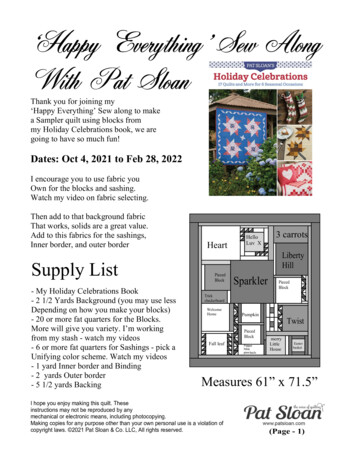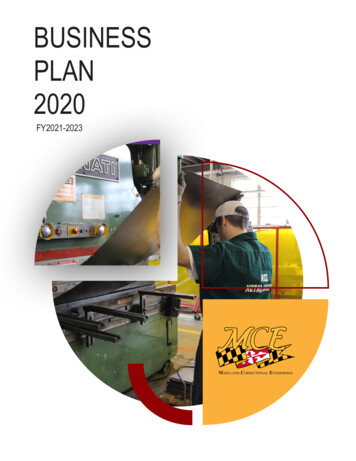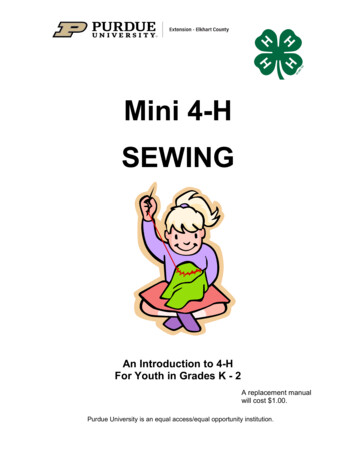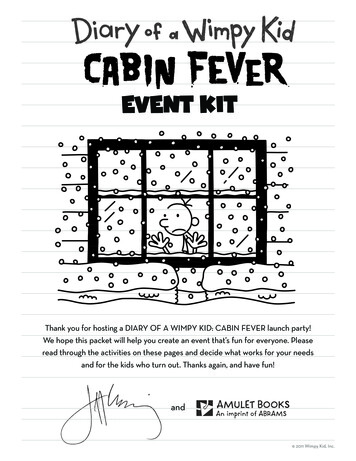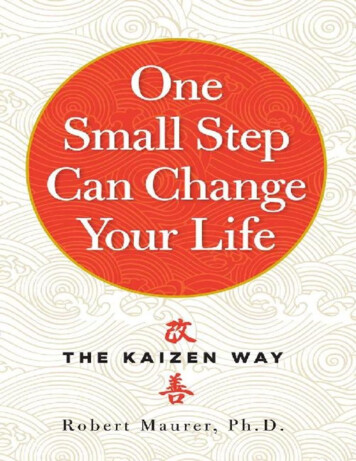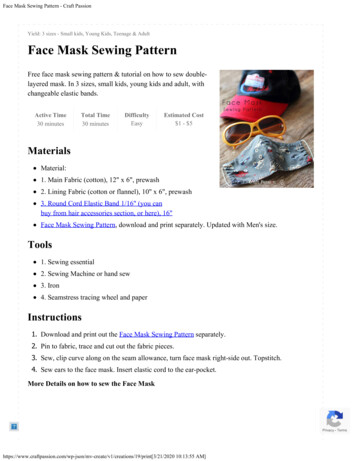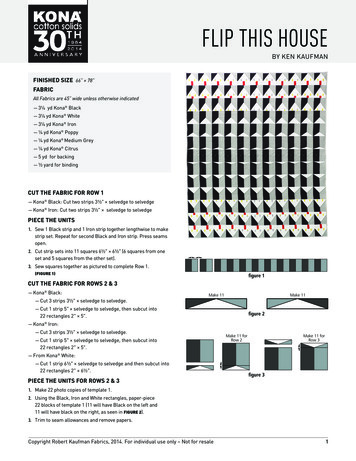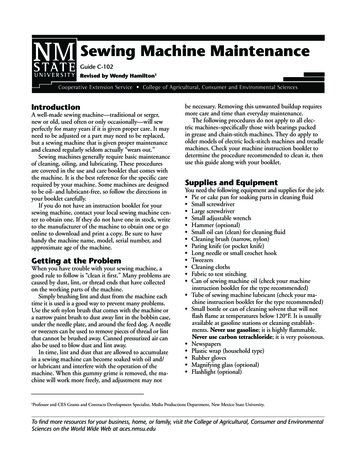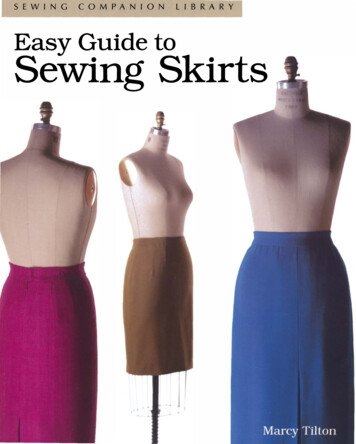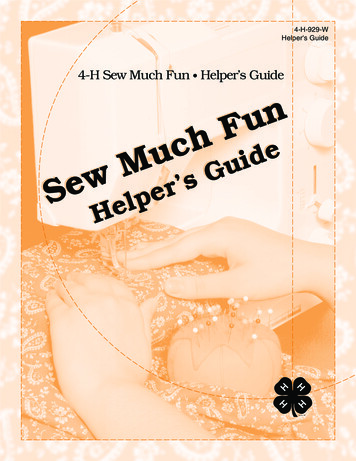
Transcription
4-H-929-WHelper's Guide4-H Sew Much Fun Helper’s GuidenuFhceudiuMGsw’ereSplHe1
“Sew Much Fun” is a series of activity guides to be used with Let’s Sew! A Beginner’sSewing Guide by Nancy Zieman (4-H-924). The series consists of five publications: Sew Simple for youth in Grades 3-4 (4-H-925)Sew Smart for youth in Grades 5-6 (4-H-926)Sew Fine for youth in Grades 7-9 (4-H-927)And Sew On for youth in Grades 10-12 (4-H-928)Sew Much Fun Helper’s Guide (4-H-929-W)Helper/Leader’s GuideCongratulations on your decision to be a “helper” to young people involved in the SewMuch Fun series. The helper’s role is critical in providing an opportunity for youth tolearn and grow in a supportive environment. This guide has been designed to provideyou with an overview of the new Sew Much Fun series. The Helper’s Guide containshelpful hints for working with young people, developing life skills, and teachingexperientially.Youth Activity GuidesThe activity guides were written to be developmentally appropriate for specific grades,but they may be used by youths in any grade depending on their interest, skills, andexperience. Each guide includes suggested reading, learning activities, skill tips, ideasfor both wearable and non-wearable sewn items, and an achievement sheet. The learnby-doing activities can be adapted to family, classroom, home school, club, and othereducational settings.Design and writing:Renee McKee, Purdue University;Peggy Latta, LattitudesEditor:Frank Koontz, Purdue UniversityGraphics:Aaron DelaneyLayout:Nancy Bangel, Dan Annarino, Purdue UniversityReview and pilot team:Jackie Benham, Sharon Blasky, Lori Bouslog, Julie Hart, Andrea Hatfield, Doug Keenan,Dotty Keeton, Penny Lee, Carolyn Miner, Amy Nierman, Scott Ripberger, Marcia Werne,Carol Christenberry, Kay Edsall, Nancy Gluth, Marie Jackson, Gwen Jones, AbbyJournay, Peggy Latta, Melinda Lay, Karen Richard, and Becky Swails2
Sew Much Fun Helper's GuideTable of ContentsExperiential Learning Model . . . . . . . . . . . . . . . . . . . . . . . . . . . . . . . . . . . . . . . . . . . . 4Developing Subject Matter and Youth Development SkillsSubject Matter Skills . . . . . . . . . . . . . . . . . . . . . . . . . . . . . . . . . . . . . . . . . . . . . . 4Youth Development Skills . . . . . . . . . . . . . . . . . . . . . . . . . . . . . . . . . . . . . . . . . . 5The Design of the Sewing Curriculum . . . . . . . . . . . . . . . . . . . . . . . . . . . . . . . . . . . . . 5Learning Activities to Be Achieved by Grade Level. . . . . . . . . . . . . . . . . . . . . . . . . . . 6-7Exhibits and Skills to Include . . . . . . . . . . . . . . . . . . . . . . . . . . . . . . . . . . . . . . . . . . 8-10Youth Learning Characteristics10-11 Years Old . . . . . . . . . . . . . . . . . . . . . . . . . . . . . . . . . . . . . . . . . . . . . . . . 1112-13 Years Old . . . . . . . . . . . . . . . . . . . . . . . . . . . . . . . . . . . . . . . . . . . . . . . . 1114-16 Years Old . . . . . . . . . . . . . . . . . . . . . . . . . . . . . . . . . . . . . . . . . . . . . . . . 1217-19 Years Old . . . . . . . . . . . . . . . . . . . . . . . . . . . . . . . . . . . . . . . . . . . . . . . . 12Action Demonstrations . . . . . . . . . . . . . . . . . . . . . . . . . . . . . . . . . . . . . . . . . . . . . . . 12Action Demonstration Checklist . . . . . . . . . . . . . . . . . . . . . . . . . . . . . . . . . . . . . . . . . 13Sample Sewing Score Sheets . . . . . . . . . . . . . . . . . . . . . . . . . . . . . . . . . . . . . . . . 14-15Glossary of Terms . . . . . . . . . . . . . . . . . . . . . . . . . . . . . . . . . . . . . . . . . . . . . . . . . 16-193
Sew Much Fun Helper's GuideExperiential Learning Model“Learning by doing” is one of the primary reasons 4-H hasbeen so widely recognized and respected in the field of nonformal education. Experiential learning distinguishes 4-Hyouth development education from many formal educational methods. Activities are designed so youth “learn bydoing” an activity. They then discuss or reflect on whatthey did, draw conclusions from the activity, and thenapply their experience to other real world situations.Project helpers “guide” youth as they explore an activity.Youth will answer questions on record sheets at the endof each activity guide to help them generalize the youthdevelopment and subject matter skills they practiced and toshare how they will apply the skills to other situations.Developing Subject Matter andYouth Development SkillsThe sewing curriculum is designed to help youth develop both subject matter skillsand youth development skills. Subject matter skills are specific to the sewing subjectmatter, such as learning to use the sewing machine, to straighten fabric, or to fit, place,and cut out a pattern. Youth development skills are developed during the process ofdoing an activity, and they are useful long after the member completes the project.Youth development skills that are emphasized in the Sew Much Fun series are decisionmaking, planning and organizing, and resource management. Some of the activities alsogive young people a chance to practice these youth development skills: processing information, practicing creativity, solving problems, learning to learn, achieving goals,mastering technology, and completing a project or task.Subject Matter SkillsThis sewing curriculum has a more defined focus than the previous 4-H clothingcurriculum. Rather than focusing solely on constructing garments, the Sew Much Funseries is designed to help youth develop basic sewing skills whether they choose toconstruct garments or prefer to make items for the home. The subject matter skillsbuilt into the curriculum fall into four categories: Machine skills Construction techniques Equipment, tools, and notions Fabric and patterns4
Youth Development SkillsThe youth development skills involved in this curriculum are part of the Four-FoldYouth Development Model. The model encompasses the skills that a young person needsto become a confident, capable, caring, and responsible citizen (Barkman, et. al. 1999).Skills are grouped into the four H’s in the 4-H clover – Head, Heart, Hands, and Health.Four-Fold Youth Development ModelHEADHEARTUtilizing ScientificMethodsProcessing InformationSelf EsteemUnderstanding SystemsManaging ResourcesPracticing CreativityMaking DecisionsSolving ProblemsVisualizing InformationLearning to LearnReasoningThinking CriticallyKeeping RecordsPlanning & OrganizingAchieving GoalsNavigating in YourEnvironmentWorking with NumbersCommunicatingInteracting SociallyCooperatingSharingResolving ConflictsValuing Social JusticeValuing DiversityBuilding RelationshipsCaring for OthersBeing EmpatheticHANDSMastering TechnologyLearning ThroughCommunity ServiceBeing a ResponsibleCitizenWorking in a TeamExercising LeadershipCompleting aProject/TaskMotivating YourselfVolunteeringHEALTHBeing ResponsibleDeveloping Self EsteemManaging YourselfPracticing Integrity &CharacterDeveloping a PositiveView of the FutureBeing ResilientManaging StressMaking HealthyLifestyle ChoicesPreventing PersonalInjuryExpressing EmotionsPositivelyPreventing DiseaseDeveloping a Sense ofPurposeUtilizing ResistanceSkillsThe Design of the Sewing CurriculumThe design and pilot team for the Sew Much Fun series decided that it was imperativeto encourage an interest in sewing (be it garment construction or home sewing). Thedesign team felt it was unnecessary to produce a sewing skills instruction manual whena resource such as Let’s Sew: A Beginner’s Sewing Guide by Nancy Zieman was availablefor purchase. The resulting curriculum was built on the foundation available inZieman’s book. The team identified specific skills, from basic to advanced, and specificlearning activities before determining the types of exhibits through which the skillscould be displayed. Following are the flow charts utilized by the team in the design ofthe Sew Much Fun series.5
6Choosing pattern sizeChoosing suitable fabricPrewashing fabricCutting pattern and fabricCoordinating fabric andpatternTypes of grainlinesReading the patternguidesheetTransferring patternmarkingsLearn about kinds of fabricsReading bolt end informationSimple pattern adjustmentsBasic matching skillsChoosing compatiblepatternsReading pattern descriptionsLearn about napped fabricSelecting notions for projectHow to pin and cutUsing the ironUsing a seam gaugeUses for measuring tapeSimple marking techniquesLearning to press as you sewUsing a seam ripperUsing waistband interfacingWorking with fiberfillLearn other markingtechniquesUsing fiberfillInterfacings suitable forwovensLearn about machine andhand needlesPressing tools: ham andsleeve rollSelecting buttons and zippersStraight and curved stitchingInserting and joining elastic or drawstringSimple seam finishStitch in the ditchTrimming a crotch curveMachine topstitch hemsLearn sewing termsBackstitchingStaystitching and understitchingLearn other seam finishesTrimming and grading seamsUsing a simple liningApplying a facing or bindingBasting and directional stitchingStaystitching and understitchingTopstitchingUses for zigzag stitchingGathering fabricSewing patch or inseam pocketsSewing a “flat method” sleeveInserting a zipperMachine blind hemApplying purchased trim or ribbingButtonhole marking, placement, cuttingInserting a lapped zipperStitching dartsInserting a set-in sleeveSewing a simple collar (without collar band)Hemming: hand, topstitched, and machineblind hemsSewing on buttons, hooks, and snapsSewing ruffles, tucks, or pleatsInserting pipingThreadingWinding a bobbinRunning the machineAdjusting tensionAdjusting stitch lengthReplacing needlePivotingUsing accessory feetUsing the sergerMaking buttonholesUsing the zipper footUsing a sergerApplying NOTIONSCONSTRUCTION TECHNIQUESMACHINE SKILLSGRADELearning Activities to Be Achieved by Grade Level
7Learn about specialty fabrics:satin, chiffon, suede, silk,lace, velvet, heavy coatings,imitation fur, and leatherChoose patterns that willoffer learning challengesLearn how to accuratelymeasure your figure andalter patternsLearn to correctly fit pantsContinue building on skillslearnedRefine use of pressingequipmentExpand knowledge ofinterfacingsContinue reading currentsewing publicationsExplore sewing resourcesonlineExplore notions departmentfor new productsContinue building on skills learnedLining more difficult garmentsUsing darts, tucks, and advanced seaming styles tobuild shape to garmentsRefine hand-sewing techniquesLearn advanced seam finishesLearn more advanced tailoring techniquesExplore unique sleeve stylesExpand knowledge and experience with zipperapplications10-12Learn more advanceduses for machineaccessoriesRefine use of sergerSelect challenging patterns,projects, and fabricsCorrectly fit pantsContinue to use new types ofinterfacingExpand use of pressingequipmentExpand use of sewingpublicationsMake self-covered buttonsUtilize specialty threadsApplying invisible and hand-picked zippersUsing advanced seaming stylesApplying bound buttonholes and welt pocketsPracticing sample tailoring techniquesConstructing button loopsApplying hand beadingPractice advanced usesof machine accessories8-9Learn about knit andspecialty fabricsPurchasing ribbingAltering pattern for better fitUsing a pressing clothLearn about interfacingsfor knitRead an issue of a sewingpublicationUses for a double (twin)needleUses for doll jointsExplore other zipper applicationsUsing a simple liningSewing a collar with a bandSewing plackets and cuffsAttaching ribbingApplying hand appliquéApplying front hip pocketsFABRIC/PATTERNBasic machinemaintenanceMachine adjustmentsfor knitConstructing with asergerMachine quiltingEQUIPMENT/TOOLS/NOTIONS7CONSTRUCTION TECHNIQUESMACHINE SKILLSGRADELearning Activities to Be Achieved by Grade Level
8Simple shirt with sleevesSundress or jumperSimple two-piece pajamaPillow lap quilt (quillow)Structured duffel bag, tote bag, or backpackSewn hatSeam finishes are recommended on all exposed seams (exceptknits). Interfacing, understitching, and trimming should beused when appropriate. Choose at least three of theseadditional skills for each sewn exhibit:Match fabric designSew a simple sleeveApply purchased trim or ribbing Sew with knitSew patch or inseam pocketsGather fabricInsert elasticHand-stitch a hemApply bindingInsert a zipperDo a machine blind hemApply facingsUse a simple liningApply machine topstitchingUse battingUse a drawstringDo a machine-topstitched hemSew buttonsSeam finishes are recommended on all exposed seams.Choose at least two of these skills for each sewn exhibit:Use interfacingStaystitch and understitchApply a facing or bindingStitch curved seamsTrim and grade seamsWork with fiberfillMachine topstitch hemsShaped pillow with curved seams, stuffed andsewn closedHanging pocket organizerBound-edge placemats (set of 4)Shorts, pants, or skirtwith partial or fullsewn-on waistband,or waistline facingSimple shirt or topBBQ apron45Choose at least two:Insert elastic or drawstringMachine topstitch hemsUse a simple seam finishStitch in the ditchSew and trim a crotch curveSKILLS TO INCLUDE IN EXHIBITSimple pillow sham with lapped back openingand purchased pillow formSimple totebag with handles or drawstringNON-WEARABLE AND ACCESSORIESElastic waist shorts,pants, or skirt withfold over casing;no pocketsWEARABLE3GRADEExhibits and Skills to Include
976GRADESchool or sports outfit –can be one or morepiecesTwo garments that can beworn togetherWEARABLEDressed, jointed stuffed animalSewn item for holiday or special occasionConstruction techniques sample notebookPillow sham with button or zipper closing,appliquéd design, piping, or ruffle. Make yourown pillow formTotebag or duffel bag with zipper, pockets, andliningDoll or pet clothesConstruction techniques sample notebookNON-WEARABLE AND ACCESSORIESSKILLS TO INCLUDE IN EXHIBITSeam finishes are recommended on all exposed seams (exceptknits). Interfacing, understitching, and trimming should beused when appropriate. Choose at least five of these additionalskills for each sewn exhibit:Make dartsAttach cuffsSet in sleevesApply bindingSew facingSew liningApply ribbingApply rufflesApply a collarApply machine or hand appliquéApply machine topstitchingInsert pipingInsert a lapped zipperInsert an invisible zipperInsert a separating zipperInsert a fly front zipperConstruct with a sergerDo machine quiltingDo a hand-stitched hemDo a machine-topstitched hemDo a machine blind hemMatch fabric designSew on buttonsMake buttonholesApply inseam pocketsApply patch pocketsApply front hip pocketsUse a twin needleApply tucks/pleatsUse doll jointsUse fiberfillApply trimsSeam finishes are recommended on all exposed seams (exceptknits). Interfacing, understitching, and trimming should beused when appropriate. Choose at least four of these additionalskills for each sewn exhibit:Make dartsSew facingsSet in sleevesDo a machine-topstitched hemApply ribbingsInsert a zipperSew a simple collarHand-stitch a hemDo a machine blind hemApply bindingsMake buttonholesSew with knitSew tucks or pleatsMatch fabric designConstruct with a sergerSew rufflesUse fiberfillHand-sew buttonsApply machine appliquéSew inseam pocketsApply trimInsert pipingSew a simple liningApply machine topstitchingSew patch pocketsExhibits and Skills to Include
10Make dartsAdd facingsMatch fabric designAdd patch pocketsAttach cuffsAdd gathersSew with difficult fabricSew with knitAdd front hip pocketsMake shoulder padsMake self-enclosed seamsUse shaped seamsCreate bound edgesUse twin needlesUse fiberfillAdd boningAdd ventsAdd underliningMake button loopsInsert a separating zipperDo a machine-topstitched hemMake bound buttonholesMake machine buttonholesApply a collarDo machine or hand quiltingConstruct with a sergerAdd placketsApply machine topstitchingAdd a drawstringInsert an invisible zipperInsert a fly front zipperDo a machine blind hemMake pleatsMake sleevesAdd liningApply machine or handappliquéDo hand beadingAdd lapelsUse specialty threadsAdd rufflesAdd inseam pocketsInsert a lapped zipperDo a hand-stitched hemInsert elasticMake tucksInsert pipingApply ribbingApply trimMake a neckbandSew on buttonsAdd a waistbandAdd welt pocketsInsert a hand-picked zipperMake self-covered buttonsSeam finishes are recommended on all exposed seams (exceptknits and some specialty fabrics). Interfacing, understitching,and trimming should be used when appropriate. Plus chooseat least six of these additional skills for each sewn exhibit:SKILLS TO INCLUDE IN EXHIBITDEFINITION OF AN OUTFIT: An outfit is a garment or garments that whenput together make a complete look, such as a one- or two-piece dress;one- or two-piece pant suit; or a three-piece combination such as pants,vest, and shirt.Sewing machine survey: Visit at least twomachine dealers and learn about thevarious models that are available.Compile your research into a notebookand list such findings as cost, machinefeatures, literature collected, and otherinformation that would help detail yourresearch. Include sewing machines andsergers. Your report should cover at leasteight different models.* Choose from the categories listed above, following county rules.Free Choice: These are garmentswhich do not fit in the other classifications. Examples include: tenniswear, swimwear or other activesportswear; lounge wear; riding habits;historic, dance, theatrical or international costumes; and unlined coats.Suit or Coat: The suit consists of twopieces: a skirt or pants and its ownlined jacket. It is not a dress with ajacket. The coat is a separate linedcoat for your wardrobe. It willbe judged separately as a coat withits own accessories.Separates: Consists of three garmentsthat must be worn as a coordinated,complete outfit. Each piece should beversatile enough to be worn with othergarments in your wardrobe.Dress Up: This is suitable for special,church, or social occasions that arenot considered to be formal.It may be an outfit of one or morepieces with or without its owncostume coat or jacket (lined orunlined). This is not an outfit thatwould be worn to school.Construction techniques sample notebook:Assemble a notebook of sewing samplesincluding the samples listed in Level B:Grade 6 and Level C: Grade 7. Continuethe book by adding advanced techniquesof seaming, seam finishes, zipper application, bound buttonholes, welt pockets,serger samples, additional fabricswatches, and other advanced techniquesthat you are interested in testing.Organize your notebook using pagedividers. Include a separate sheet listingat least 10 techniques that you haveadded to your notebook this year.Sewn items for your home: Be creative inyour choices. Make items that reflectyour level of sewing. Be sure to includethe correct number of skills. Divisions1-5: Include at least six of the skills listedto the right.School Wear: A complete outfit of oneor two pieces suitable for school wear.8-12*Formal Wear: This outfit may be oneor more pieces suitable for any formaloccasion, such as a prom, wedding,or formal evening function.NON-WEARABLE AND ACCESSORIESWEARABLEGRADEExhibits and Skills to Include
Youth Learning CharacteristicsBelow you will find a list of characteristics that are common to children in four agelevels. Please remember, however, that children develop at their own pace, and all characteristics will not be observed in all children at the same age. You should find thisoutline helpful as you work with youth of different ages. (Adapted from Ages and Stagesof Child and Youth Development [NCR-292] by Judith Myers-Walls, associate professor,Child Development and Family Studies, Purdue University.)10-11 Years Old Are active, full of energy, and anything but quiet. Activities should encouragephysical involvement. May often change interests, jumping from one thing to another. Activities dividedinto small pieces or steps work best. Are fairly concrete thinkers and tend to be more attentive if they have an opportunityfor hands-on learning (seeing and doing, rather than just listening). Are just beginning to think logically and symbolically and are beginning to understand abstract ideas. As they consider an idea, they think it is either right orwrong, fun or boring (there is very little middle ground). Look for adult approval and have a strong need to feel accepted and worthwhile.Adults should provide lots of encouragement and recognize even small successes. Prefer individual evaluation to group competition. Instead of comparing successwith others, youngsters prefer to know how much they have improved and whatthey should do to be better next time. They are easily embarrassed about doingeither better or worse than their friend. Are beginning to move out of the stage in which the satisfaction of completing aproject often comes from pleasing the leader or parent rather than from the valueof the activity itself.12-13 Years Old May begin growth spurts at this age, with girls maturing faster than boys. Theserapid changes may make some teens uncomfortable with their changing bodyimages. Approach of puberty sets off a roller coaster ride of hormones and emotions, presenting a major challenge to a young person’s self-concept. Are faced with so many changes, they hardly know who they are. They begin totest values and identities and seek adults who are accepting and willing to talkabout values and morals. Desire a sense of independence from parents, and are concerned about being likedby friends. Opinions of peers become more important than opinions of parentsand other adults in the areas of dress, music, and activities. Are moving from concrete to more abstract thinking. Ready-made solutions fromadults are often rejected in favor of finding their own solutions. Small groupsprovide an opportunity to test ideas. Are easily embarrassed by comparisons to other young people. They want to bepart of something that is important and that provides an opportunity to developresponsibility. Place importance on justice and equality. Judging of projects is viewed in terms ofwhat is fair. Ribbons are seen as reflections of the individual’s self-worth insteadof feedback on a specific project.11
14-16 Years Old Tend to be very concerned with themselves and their peer group. Relationshipskills become a priority. Many begin dating, and acceptance by members of theopposite sex may become important. Are becoming aware of their own special abilities and talents, so this is a goodtime to introduce them to leadership roles. Are beginning to think about the future and make realistic plans, so their vocational goals often influence the activities they select. Are mastering abstract thinking, so they imagine new ways of doing things thatsometimes challenge adults. Set their goals based on feelings of personal need and priorities. Any goals set byothers are likely to be rejected. Can initiate and complete tasks without supervision. Leader’s role should be thatof adviser/coach.17-19 Years Old Place importance on future plans as they begin making the transition to adult life.Their goals for the future influence which activities they continue. Determine their own schedule, in most cases, and only general directions areneeded when they are assigned familiar tasks. Develop close relationships as they become preoccupied with their need for intimacy. Make and carry out serious decisions, but still need adults for support and guidance. Adults no longer control activities, but should serve as resource people,helping to stimulate teens’ thoughts.Action DemonstrationsAn action demonstration is a fun way for a 4-H member to share with others what heor she has learned from the 4-H project. It is similar to the show and tell from school,but the 4-H’er devotes more attention to getting the audience involved in a hands-onactivity instead of just showing them. Action demonstrations can be given anywherethere is a group of people, such as a county or state fair, shopping mall, street fair, or 4-Hevent. The demonstrator’s job is to interest people in the topic being presented so theywill stop and try their hand at what is being done. The best way to attract attention is byhaving people around a table doing an activity. People love to do hands-on activities, soa few people at the table doing something will attract others. The audience may beinvolved by doing what the demonstrator is doing, judging the quality of various items,playing a game, or answering questions. Some suggestions for sewing action demonstrations: Demonstrate sewing on a button and have extra buttons, needles, thread, andfabric so others can try. Talk about types of zipper applications or seam finishes and show both good andpoor examples that the audience can judge.12
13
Sample Score SheetsSew Much Fun Score SheetSkirt, Shorts, or Pants with Elastic Waist4-H 930ANew 8/014-H 930BNew 8/01Sew Much Fun Score SheetBlouses, Shirts, and VestsNameNameClubPlacingvery goodgoodClubPlacingvery goodneedsimprovementgoodneedsimprovementGENERAL APPEARANCECleanlinessPressedSELECTIONChoice of patternChoice of fabricChoice of notionsWORKMANSHIPDarts, gathers, pleatsCollarFacingsInterfacingsLiningsSeams (finish and width)Buttonholes, snaps, etc.SleevesCuffsHemsStitching — machineStitching — handGENERAL APPEARANCECleanlinessPressedSELECTIONChoice of patternChoice of fabricChoice of threadWORKMANSHIPCut on grainStitching straightStitching — no loose threadsStitching even/tensionSeams pressed openSeam finishHeading even in widthElastic flat and secureCrotch curveHemsExhibit contains the required number of skills for this level: YES NOExhibit contains the required number of skills for this level: YES NOCOMMENTS:COMMENTS:4-H 930DNew 8/014-H 930CNew 8/01Sew Much Fun Score SheetMiscellaneous ItemsSew Much Fun Score SheetSkirt, Shorts, or Pants with ZipperNameNameClubClubPlacingvery goodgoodPlacingType of Articleneedsimprovementvery goodGENERAL APPEARANCECleanlinessPressedSELECTIONChoice of patternChoice of fabricChoice of notionsWORKMANSHIPCut on grainStitching — machineStitching — handSeams pressed openSeam finishPlacket/zipperCrotch curvePocketsDarts, gathers, pleatsWaistbandButtons, hooks, snapsHemsgoodneedsimprovementGENERAL APPEARANCECleanlinessPressedSELECTIONChoice of patternChoice of fabricChoice of notionsWORKMANSHIPCut on grainSeam finishEnclosed seamsInterfacingLiningFlat corners/no excess bulkHems evenCurved seams lie flatStitching — machineStitching — handZipperUse of batting/fiberfillAppliquéTrimsExhibit contains the required number of skills for this level: YES NOCOMMENTS:Exhibit contains the required number of skills for this level: YES NOCOMMENTS:14
Sample Score Sheets4-H 930FNew 8/014-H 930ENew 8/01Sew Much Fun Score SheetSuits, Jackets, and CoatsSew Much Fun Score SheetDresses and JumpersNameNameClubClubPlacingvery goodgoodPlacingvery goodneedsimprovementgoodneedsimprovementGENERAL APPEARANCECleanlinessPressedSELECTIONChoice of patternChoice of fabricChoice of notionsWORKMANSHIPDarts, gathers, et/zipperButtonholes, snaps, etc.WaistbandPocketsSleevesShoulder padsHemsSeams (width and finish)Enclosed seamsStitching — machineStitching — handGENERAL APPEARANCECleanlinessPressedSELECTIONChoice of patternChoice of fabricChoice of notionsWORKMANSHIPDarts, gathers, pleatsCollarFacingsInterfacingsLiningsSeams (finish and width)Enclosed seamsZipper or closingButtonholes, snaps, etc.SleevesWaistlineHemsEnclosed seamsStitching — machineStitching — handExhibit contains the required number of skills for this level: YES NOExhibit contains the required number of skills for this level: YES NOCOMMENTS:COMMENTS:4-H 930HNew 8/014-H 930GNew 8/01Sew Much Fun Score SheetConstruction Samples NotebookSew Much Fun Score SheetSewing Machine SurveyNameNameClubClubPlacingvery goodgoodneedsimprovementPlacingvery goodGENERAL NOTEBOOKOrganized presentationSpelling and grammarCharts, graphs, labelsINFORMATIONSewing machinesSergersCostsFeaturesProduct literatureOther detailsgoodneedsimprovementGENERAL APPEARANCEOrganized presentationCharts, graphs, labelsSamples securely mountedCONSTRUCTION SAMPLES (not all samples required for eachlevel; see project guidelines for specific requirements)Marking techniquesSeamsSeam dstitching samplerTopstitchingFabric swatchesSerger swatchesOtherReport meets all requirements for this level: YES NOCOMMENTS:Notebook meets all requirements for this level: YES NOCOMMENTS:15
GlossaryLevels A, B, and C of the sewing manuals each contain a glossary. Terms found in thoseglossaries are italicized, underlined, and in bold type when they first appear in the manual. This isan alphabetized list of the terms from all three of those glossaries. Some terms appear twice in thislist because they appear in different levels of the curriculum with slightly different definitions. Theearliest definition appears first.Adjustment line – pattern marking or a line drawn on pattern for lengthening or shortening. (Level B)Appliqué – a decoration made by cutting pieces of one fabric and applying them to the surface ofanother. (Level B)Backstitching – stitches that are made at the beginning and end of a line of stitching to keep thethreads from pulling loose. To backstitch, place the needle 1/2" from the edge of the fabric andstitch back to the edge. Stitch forward to the other end of the seam, and then stitch backward1/2". The two lines of stitching should be right on top of each other. (Level A)Backstitching – taking short backward stitches to secure a line of stitching. (Level B)Baste – a way to hold items together by using large stitches that will be taken out later. Set thesewing machine for six stitches to an inch for basting. (Level A)Basting – long temporary stitches used to hold fabric in place during fitting or construc
2 “Sew Much Fun” is a series of activity guides to be used with Let’s Sew! A Beginner’s Sewing Guide by Nancy Zieman (4-H-924). The series consists of five publications: Sew Simple for youth in Grades 3-4 (4-H-925) Sew Smart for youth in Grades 5-6 (4-H-926) Sew Fine for youth in Grades 7-9 (
